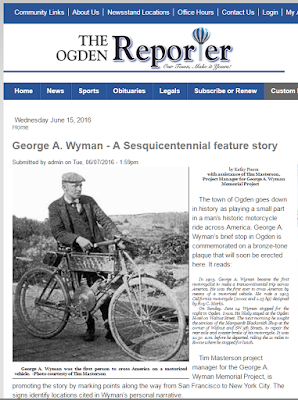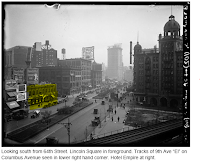Riding the last leg of his historic journey across America, Wyman was on pace reach New York City by July 4th. The toll on him and his motorcycle was accumulating with each day. During his five day repair layover in Chicago he remarked that he grew soft. The two day ride from Chicago to Perrysburg, Ohio, left him feeling very "saddle-sore" to the point of wishing he had a hot water bag for a seat cover. Constant issues with the motorcycle were also wearing on his determination. Everyday was filled with multiple frustrating stops to make adjustments and repairs.
After a quick breakfast, Wyman retrieved his motorcycle from the Perrysburg Post Office, where he stored it for the night. It was around 7 am, Friday, June 26, when he left town along the road, which is now the "Fremont Pike," US-20. He soon discovered the motorcycle was running low on motor oil. Wyman calculated that he had enough oil to last for about 30 miles of normal riding. He decided to alternate between riding under power and peddling.
It was mid morning when he rode into Fremont along West State Street to the center of town. In 1903, Fremont, Ohio was a bustling community of 8,400+ in the industrial heartland of America. Wyman quickly found a local machine shop and obtained oil for his motor. Apparently, he didn't pay much attention to the container of oil until he started to pour it into the oil reservoir. It was so thick he had to heat it up before it would flow out of the can.
Eager to make up time and with the oil issue resolved, Wyman departed Fremont east over the Sandusky River Bridge along State Street. He wanted to make it all the way to Cleveland before stopping for the night. Winding along the rural roads, the path was again beset with muddy and sandy conditions. Sometimes the sudden changes in the road surface would cause Wyman to fall. This happened more frequently than he would mention, remarking once that his reports would be nothing but accounts of one fall after another. It was just part of the ride for him, a price he had to pay to reach his ultimate objective.
About 30 miles from Cleveland, near the west side of Amherst, Wyman noticed a piece of his front suspension was broken. Stopping to examine it, he discovered part of the reinforcing bars of his front forks had snapped. The truss, which stiffens the front forks, had suffered metal fatigue from the constant pounding while riding. He also spotted several more cracks and fractures in the truss that had became brittle. Thoughts raced through his mind of this condition extending to the rest of the motorcycle. This weakening of the front suspension would spell trouble for him down the road. Resolved there was little he could do about it in the middle of the country side, he pressed on.
The roads to Amherst, through Elyria and beyond were in bad shape. Usually, he would be forced to walk the motorcycle for long stretches at a time. Luckily, Wyman found a good stretch of riding surface along a side path. At one point, he passed an automobile struggling though the ruts and sand pits, barely moving, its engine laboring. He thought himself fortunate to be able to ride over narrow slices of good surface. Six miles out of Cleveland his luck improved. He would remark it was some of the best road he had encountered during the entire trip.

Wyman rode into Cleveland at around 7 pm that evening. The first thing on his agenda was to get some better motor oil. He went to the "Oldsmobile branch" in the heart of downtown. The Ohio Oldsmobile Company, listed in the 1903 Cleveland business directory at 411 Euclid Avenue, was the auto makers' dealer or "agent" as they were referred to then. The mechanics at the Oldsmobile garage were very interested in his machine. At first the fellows didn't believe Wyman's story about riding all the way from San Francisco. When he showed them pictures of his start in San Francisco, they gave him as much motor oil as he could carry. He would get a late start the next day as he took advantage of the garage facilities, to work on his bike.
Wyman's 121 mile ride from Perrysburg to Cleveland took 12 hours. He used five quarts of gasoline and a quantity of thick machine shop oil. Read Wyman's account of his ride from Perrysburg to Cleveland, Ohio, on Friday, June 26, 1903...in his own words:
"About this time I began to feel the effects of my five days' rest in Chicago. That length of time led to my growing tender. and I was more saddle-sore at Perrysburg that night than at anytime before. I felt then as if I would have to finish with a hot water bag on the saddle.
From Perrysburg I got a 7 o'clock start, but soon discovered that I did not have any more lubricating oil than enough to last for 30 miles. By economizing I managed to reach Tremont(sic Fremont) where I got some oil at a machine shop. It was so thick that I had to heat it before it would run, but it was better than nothing. After leaving Fremont the roads began to grow very poor. There had been several days of rain on them Just before I came along and as they were simply dirty roads for repeated stretches of 10 miles or more the mud was deep and wide.
Near Amherst about 30 miles west of Cleveland I got my first reminder of the one-horse story and a foretaste of what was in store for me. The truss on the front forks of my bicycle broke. When I stopped to remove the remains of it, I found that it had crystallized so that it was like a piece of old rusty iron. It broke in several places like a stick of rotten wood. That was the effect of the terrible pounding the machine had received over the railroad ties. It occurred to me at the time that the whole machine must have suffered similarly, but it did not show signs of disintegrating at the time, and I concluded it would carry me to New York. After leaving Elyria, 25 miles from Cleveland, I struck a good sidepath that continued for 20 miles. It was only six inches wide in places, but those few inches spelled salvation for me, because the road was so heavy with sand that if I had not had the path to ride I would have had to have walked for long stretches. Just out of Elyria I met an automobile, and it was having a hard time of it. It was all the engine could do to keep it moving. The last five miles into Cleveland I went over the best roads I ever had ridden on anywhere in my life.
It was 7 p.m. when I reached Cleveland. and my first move was to hunt up an automobile station in order to get some oil. At the Oldsmobile branch I found what I wanted, and they gave me enough to last for 300 miles, all I cared to carry, in fact. They took a lively interest in me and my bicycle and examined my motor carefully. Like everyone else, though, they had to be shown the photographs of my start from San Francisco before fully accepting my statement that I had come from California. My distance for this day, to Cleveland, was 121 miles, and I used five quarts of gasoline."
G.A. Wyman, "Along The Shores Of The Great Lakes And Down The Hudson To New York", The Motorcycle Magazine, October, 1903
The
City of Fremont, Ohio has joined the Project as a hosting community. We thank Mayor Daniel Sanchez and the citizens of Fremont for enriching the history of their community with the Wyman story. Together, we are...
"Linking the Past to the Present to Enrich the Future"








































